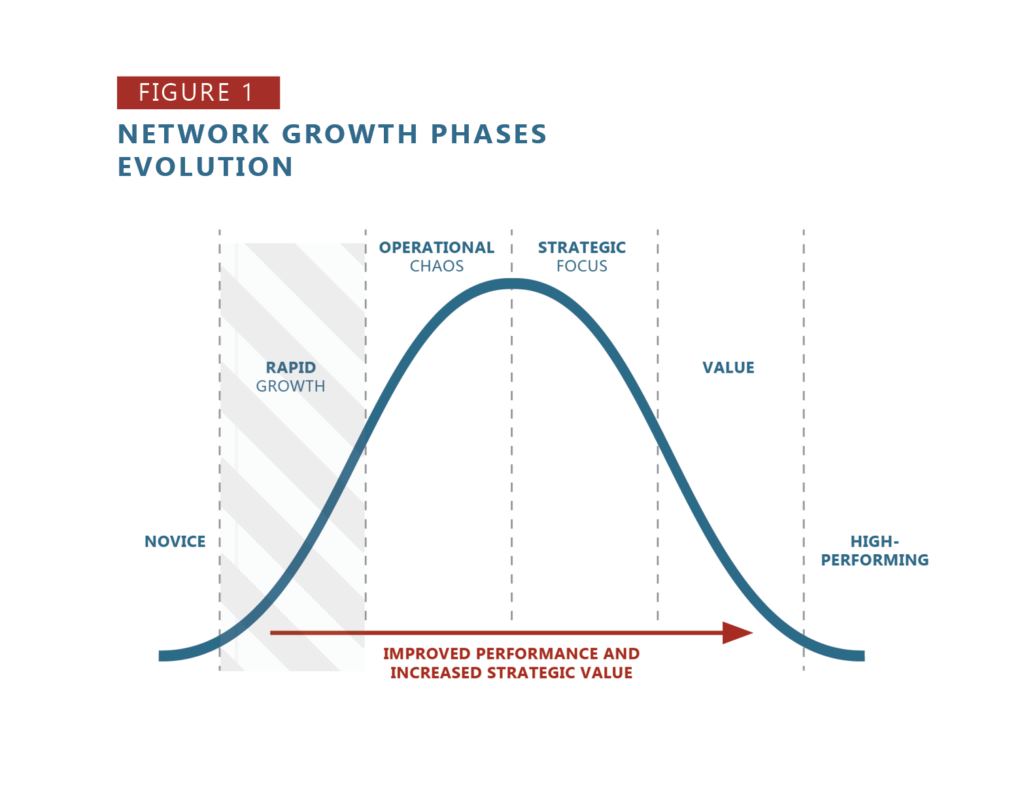
|
Download a PDF Version of the Article to Share With Your Team |
Physician Network Executives: Do You Have the Right Leaders in Place?
Today’s physician network leader needs to do more than maximize revenue and minimize losses. To ensure success in the coming years, network executives must understand how to use market intel and data to increase market share and use that leverage with payors.
For years, while physician networks were in Rapid Growth (Figure 1), the measure of management success was based on the ability to recruit the right doctors – in many cases, highly-paid specialists who are critical to the hospital’s signature service lines. In the current healthcare environment, it is equally important to have a primary care strategy to feed those specialists and the leadership acumen to manage and maximize large multi-specialty, multi-site employed physician networks.

The Skill Sets Physician Network Executives Need Today
In many cases, physician network administrators are hospital administrators that had specific responsibilities for various departments before they were in charge of the network. They may have been or could still be responsible for IT or Human Resources, the Business Office or Risk Management, Quality or Ambulatory Care.
These administrators have a clear value as they understand hospital and market economics and are in the loop on the strategic plan. They may know how to work with and influence the Board when a physician practice approaches the hospital seeking employment or bricks and mortar are required to bring physician services to a medically underserved area. Some may even know how to relate to physicians and guide them toward common goals.
Administrators are often missing an essential skill required to act as a physician network executive effectively. They lack actual experience in profitably running physician practices – scheduling patients, collecting co-pays, billing for services, closing the day – the nitty-gritty details that spell profit or loss in what is, essentially, a conglomeration of small business units. They don’t have the knowledge to standardize best practices across the network because they don’t know what best practices are. And because they lack that expertise, they can’t teach or coach up a $15 per hour clerk at the front desk.
This lack of experience and knowledge is one of the big reasons so many hospital-owned physician networks face mounting per provider losses. Other symptoms that “all is not well” in the physician network’s executive suite include:
- A lack of standardized weekly and monthly dashboard reports on network performance and operations to identify opportunities for improvement;
- The absence of dedicated resources in large networks to billing and revenue cycle;
- Insufficient understanding of payor contracts and relationships;
- A primary care physician base that’s too small to support the specialists;
- Physicians bringing problems to the C-suite when they should have already been handled by network management;
- Lack of a strategic plan for the network;
- A growing loss of referrals to physicians outside your network.
Addressing these symptoms means tackling shortfalls in management infrastructure and evaluating the individuals’ skillset within it.
Recruiting the Right Physician Network Executives
Hospital-owned, multi-specialty physician networks of 100 – 500 providers are a relatively new phenomenon in healthcare. The best candidates to fill the role of a physician network executive have grown up in physician practices. They know the ins and outs of day-to-day operations, understand billing and collections and closing the day, and have the necessary seasoning and experience to develop standardized and systemized best practices across the network.
It’s also important to specifically outline your network’s particular prerequisites before the recruiting process begins. That way, you are recruiting the experience you need to take you where you want to go tomorrow, rather than where you are today.
The last major consideration in the hiring process is cultural fit. How do a candidate’s values, personality, and style mesh with the organization’s culture and the personalities of the network’s key players? Finding the right cultural fit is an excellent predictor of a favorable hiring decision.
Phasing into New Leadership: Consider Interim Physician Network Executives
Recruiting a new physician network leader generally takes three to five months. You can take a laissez-faire approach and choose to merely babysit your network during the process. Or you can use the recruiting timeframe to jumpstart positive change through an interim executive.
An interim executive can begin to iron out a path for your new hire by:
- Identifying and prioritizing the network’s key issues;
- Providing solid recommendations for improvement;
- Developing a roadmap for the incoming new hire;
- Beginning the development of dashboard reports to monitor progress and results; and
- Insulating both the hospital and the new hire from the blow-back that can accompany change.
Today’s physician networks require experienced leadership at the executive level. If your leadership isn’t up to the job, now is the time to make a change.
